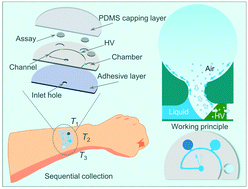Skin-interfaced microfluidic devices with one-opening chambers and hydrophobic valves for sweat collection and analysis†
Abstract
Soft, skin-interfaced microfluidic platforms are capable of capturing, storing, and assessing sweat chemistry and total sweat loss, which provides essential insight into human physiological health. However, sweat loss from the outlet of the microfluidic devices often leads to deviation of the measured concentration of the biomarker or electrolyte from the actual value. Here, we introduce hydrophobic valves at the junction of the chamber and the microfluidic channel as a new chamber design to reduce sweat evaporation. Because the advancing front of the liquid in the hydrophilic microchannel is blocked by the hydrophobic valve, the fluid flows into the chambers, forms the initial meniscus, and completely fills the chambers along the initial meniscus. Fluid dynamic modeling and numerical simulations provide critical insights into the sweat sampling mechanism into the chambers. With significantly reduced evaporation and contamination, the sweat sample can be easily stored for a long time for later analysis when in situ analysis is limited. Additionally, the design with multiple chambers can allow sequential generation of sweat collection at different times for long-term analysis. The in situ real-time measurements of the sweat loss and pH value analysis from the human subject demonstrate the practical utility of the devices in collecting, storing, and analyzing the sweat generated from sweat glands on the skin.

- This article is part of the themed collection: Wearable and Implantable Sensors


 Please wait while we load your content...
Please wait while we load your content...